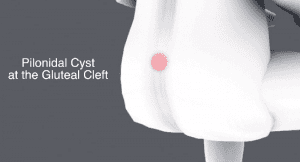Although a pilonidal cyst may start out as a minor skin irritation near your sacrum, pilonidal disease is a condition that often requires surgery. In order for you to get relief as soon as possible, it’s best to get an examination by a colorectal surgeon who can properly diagnose your situation.
Dr. Kamrava is a board-certified colorectal expert who not only has extensive experience treating pilonidal disease, but also uses the most advanced surgical techniques to help ensure a comfortable and smooth recovery process.
What Is Pilonidal Disease?
Pilonidal disease is a condition that affects the lowest area of your back near your tailbone. A bump over the tailbone near the buttocks is the most prominent physical symptom of the disease. The bump is a pilonidal cyst that typically forms after hair follicles have been pushed back into the skin, causing a localized infection.
 What Causes Pilonidal Disease?
What Causes Pilonidal Disease?
The exact cause of pilonidal cysts is unclear, but there are a number of factors that may contribute to pilonidal disease. A pilonidal cyst forms when hair enters openings in the skin, so excessive hair may increase your risk of developing pilonidal cysts. The disease became widely known during World War II when military truck drivers developed painful, abnormal skin lesions near their tailbones. Today, sitting for long periods of time or trauma to the area may also cause pilonidal disease.
Pilonidal Cyst Symptoms
When you first become aware of a pilonidal cyst, you may not have any uncomfortable symptoms. However, since the growth may easily become infected, pain and swelling in the area is common. Pilonidal disease varies in degrees of severity; certain cysts may only cause minor discomfort, while others may be quite painful. In some cases, a fever may accompany the condition.
Diagnosis and Treatment
If a pilonidal cyst becomes infected, you’ll need to see a doctor to drain the infection. An incision that drains fluid from the cyst can be performed under local anesthesia in the doctor’s office. This process will provide relief from irritating symptoms, but it does not actually treat pilonidal disease.
To address the root cause of the issue, surgery is necessary to remove the diseased skin tissue. In the past, surgery has been quite invasive, but Dr. Kamrava utilizes the rhomboid flap technique to swiftly remove the infected skin and replace the wound with a healthy flap of skin from a nearby area of the body.
 Pilonidal Disease Frequently Asked Questions
Pilonidal Disease Frequently Asked Questions
The presence of a pilonidal cyst may raise a number of concerns about pilonidal disease. While each case is different, here are answers to frequently asked questions to help you determine your next step. Please feel free to contact Dr. Kamrava at 424.279.8222 if you have additional questions that aren’t answered below.
Q: What are the symptoms of pilonidal disease?
A: You may notice a growth on the lowest part of your back—your sacrum—that is near your tailbone. The bump will be filled with fluid, and if it becomes infected, you may experience pain, swelling, redness, or a fever.
Q: Who is most likely to develop pilonidal disease?
A: If you sit for long periods of time or have had trauma to your tailbone, you may be more likely to develop pilonidal cysts. Obesity, poor hygiene, and excessive body hair are other factors that may increase your chances of getting the disease.
Q: How is pilonidal disease diagnosed?
A: When you visit an expert colorectal surgeon, he or she will be able to evaluate your skin to determine whether or not you have a pilonidal cyst. Since the disease occurs on the outside of the body, a visual examination will reveal your condition. An appropriate treatment plan will then be discussed.
Q: Can pilonidal disease be treated without surgery?
A: The symptoms of pilonidal disease can be treated without surgery, but the disease itself requires surgical intervention. The infected skin tissue needs to be properly removed to prevent recurrence of pilonidal cysts. As an initial step, a pilonidal cyst can be drained of fluid to decrease pain and swelling.
Q: What is the rhomboid flap technique?
A: In order to treat your pilonidal disease in the most revolutionary way, Dr. Kamrava uses the rhomboid flap technique to remove diseased skin. The wound is replaced with healthy skin, and the healing process is much more comfortable than older forms of surgery that required an open wound to heal over 6 – 21 weeks.
Call Today to Schedule a Pilonidal Disease Consultation With Dr. Kamrava
If you think you may be suffering from pilonidal disease, contact Dr. Kamrava to find out more about your treatment options. He is a board-certified colorectal surgeon who specializes in highly advanced surgical techniques that treat pilonidal cysts and pilonidal disease. Schedule a consultation today by calling 424.279.8222
Next, learn about anal fissures.




